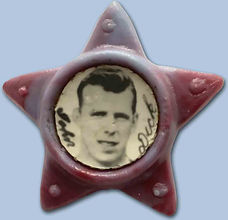
WEST HAM UNITED
theyflysohigh : Steve Marsh
FOOTBALL PROGRAMMES &
Collectables through the Decade
A Pictorial History
1960-61 Collectables
ANGLO-AMERICAN CHEWING GUM Ltd
Famous Football Clubs (1961)
Numbered series of 72. Wax paper issue depicting club colours and crest. Given free with "Bellboy" Bubble Gum.
Album issued to accompany the series.


6. West Ham United
BARRATT & Co Ltd
Famous Footballers (1960-61)
SERIES A8
Coloured, numbered series of 50 portraits of famous footballers with facsimile autographs to base. Album issued to accompany the series.

29. Phil Woosnam
50. Ken Brown
EVENING STANDARD (Newspaper)
The West Ham United Story (1960-61)
Commencing on 30 November 1960, the Evening Standard newspaper told the story of the Hammers in 50 picture format strips. The artist, Gary Keane depicts the story from their early development as Thames Ironworks, and concludes with the Second Division promotion winning campaign of 1958.
The 132 pictures consisted of either two or three pictures per strip and issued from 50 consecutive issues of the newspaper. The strips had to be cut and pasted into the appropriate spaces within the album which was priced at One Shilling (10p in today’s money).
It is interesting to note that some of the strips are on pink newsprint instead of the usual white, indicating that they were from the old evening 'classified' edition that was on sale a couple of hours after the matches played on the Saturday afternoon.

FLEETWAY PUBLICATIONS
Tiger Album of Football Club Badges
12 page booklet with spaces for 110 numbered club badges.
Issued and cut from gummed sheets inscribed "Tiger".

LEAF BRAND Inc
Footballers
Black and white, unnumbered series of 30 portraits or Portrait / Caricature cards.
Plain, anonymous backs.

NEWFOOTY
Table Soccer


Newfooty was the fore-runner to the popular Subbuteo Table Soccer game. The concept was first produced in 1929 by William Keeling.
The game played with self-righting men quickly became popular with football enthusiasts of the time. The comprehensive rules were based on those of Association Football and formulated with the object or reproducing as closely as possible the events of the football field.
Newfooty was also a bitter rival to Subbuteo in the 1950s, and advertised itself as "the Original Game". There was certainly the feeling that Peter Adolph creator of “Subbuteo” had borrowed heavily from Newfooty when producing his own table top game. The games looked pretty similar in the 1950’s, with regard to the size of the pieces and the methods of play.
In both cases the players were made of card and slotted into curved bases. The card figures from Newfooty seemed to be a simple attempt to add some 3-D to the style of game as the figures had an action pose, oppossed to the ‘Stan-up’ Subbuteo figures which illustrated a front and rear view of the player.

NEWS CHRONICLE
Paper Trade
Footballers snipped from the paper

ANONYMOUS
Star Club Badge
Plastic star badge with metal clasp to reverse.







Books & Publications
AT HOME WITH THE HAMMERS
Ted Fenton - Nicholas Kaye Ltd (1960)

Does Ted Fenton regard the manager’s job as the ‘hot seat’ of soccer?
Not so long as it is with West Ham United! The club has had only three managers in some 60 years. ‘United’ isn’t just a name.
Is he satisfied with the state of football in this country? Has he any constructive suggestions for its improvement?
Fenton lives for improvement. He wants better-class soccer for supporters, for England – for the whole world. He goes deeply into the problems of team selection on club and international level, the necessity of keeping players up to peak fitness with ‘competitive’ training – and, remember, West Ham have the reputation of being one of the fittest sides in the Football League – and varying team tactics according to weather and ground conditions. And he plans to make Upton Park a ‘show-piece stadium.
There isn’t too much of the I-kicked-a-tennis-ball-against-a-wall stuff?
None at all. Fenton couldn’t write like that. He’s too much of an individualist. He kicks off with a tale of joy – the match that meant West Ham’s return to the First Division after 26 years. He tells you exactly how they did it, too.
How does a manager set about building a winning team?
He deals with the discovery and signing of promising young players, with the club organisation that nurses them to first-class standard and the constant revision of strategy on the field and training methods. He explains why he thinks the F.A. should turn to certain club managers, all great players of their day, to make England a power in international soccer again.
But it’s impossible to tell you all Fenton writes about. This is the story of his life, and since soccer is his life it’s also the story of soccer in our time, with all the pulsating excitement of League struggles and dizzy Cup runs. You’ll revel in a book that is at once a thrilling history of a go-ahead club and a sage commentary on every phase of the game the world plays.